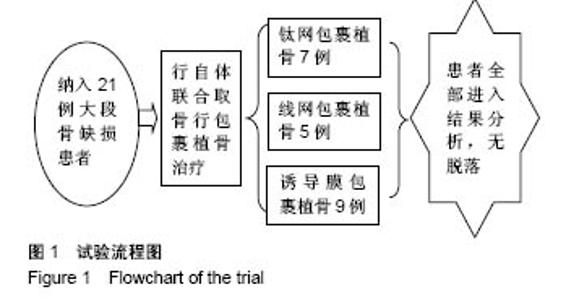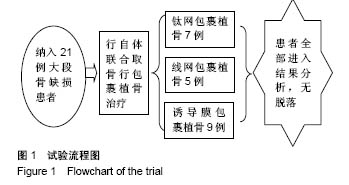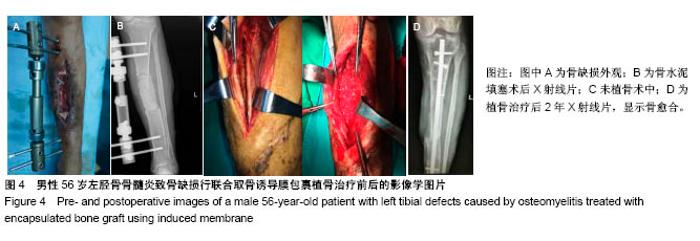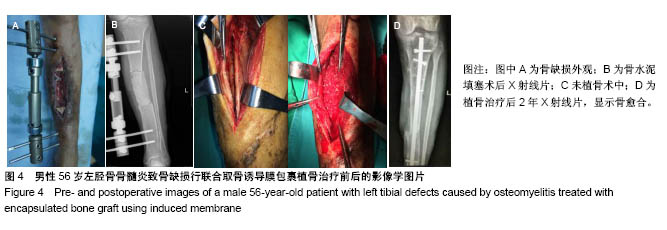| [1] 沙勇,李春晓,徐永清,等.同种异体冷冻骨移植结合外固定架支撑修复大段骨缺损[J].中国组织工程研究, 2012,16(31): 5751-5754.[2] 王国伟,孙绳亮,窦洪磊.胫骨周围筋膜瓣包裹同种异体骨修复长段骨缺损的实验研究[J].中国矫形外科杂志, 2015,23(24): 2277-2282.[3] 余凯,杨晶,杨广忠,等.Ilizarov牵拉架外固定治疗胫骨骨缺损的钢环参数选择[J].中国组织工程研究,2014,18(4):577-582.[4] 殷渠东,顾三军,芮永军,等.诱导膜技术治疗骨缺损的疗效分析[J].中华骨科杂志,2016,36(20):1284-1293.[5] 孙振中,顾三军,吴永伟,等.修复长段骨缺损的Masquelet技术[J].中国矫形外科杂志,2013,21(24):2495-2498.[6] Cobos JA,Lindsey RW,Gugala Z.The cylindrical titanium mesh cage for treatment of a long bone segmental defect:description of a new technique and report of two cases.J Orthop Trauma.2000;14(1):54-59.[7] Masquelet AC,Fitoussi F,Begue T,et al.Reconstruction of the long bones by the induced membrane and spongy autograft.Ann Chir Plast Esthet.2000;45(3):346-353.[8] 田文,吴玮伟,王富明,等.网状植骨治疗股骨中下段大段骨缺损的临床应用[J].生物骨科材料与临床研究,2012,9(6):41-44.[9] 殷渠东,芮永军,顾三军,等.改良打压游离植骨治疗长段骨缺损一例[J].中国修复重建外科杂志,2012,26(5):637-638.[10] 殷渠东,顾三军,孙振中,等.钛网打压植骨重建四肢长骨节段骨缺损[J].中国组织工程研究,2012,16(48):9096-9100.[11] 刘尧喜,梅海波,刘昆,等.四合一骨融合术在儿童先天性胫骨假关节联合手术中的应用[J].中华骨科杂志,2016,36(12):770-777.[12] Whately C,Abdallah MA,Alwatari YA.Management of large segmental tibial defects using locking IM nail and absorbable mesh[J].BMJ Case Reports.2013;2013.pii: bcr2013010480. doi: 10.1136/bcr-2013-010480.[13] Stafford PR,Norris BL.Reamer-irrigator-aspirator bone graft and bi Masquelet technique for segmental bone defect nonunions:a review of 25 cases.Injury.2010;41(Suppl 2):S72.[14] 殷渠东,顾三军,芮永军,等.松质骨包裹植骨技术治疗长骨节段性骨缺损:50例报告和文献复习[J].中华创伤骨科杂志, 2017,19(9): 775-781.[15] 殷渠东,顾三军,孙振中,等.钛网和线捆扎包裹嵌压松质骨植骨修复长骨干节段骨缺损的效果比较[J].中国骨与关节损伤杂志, 2015,30(2):189-190.[16] 张辉,许亚军,陈政,等.利用线捆绑游离皮质骨块包裹松质骨植骨治疗胫骨节段性骨缺损疗效[J].中国现代医学杂志, 2017,27(8): 109-113.[17] Paley D,Herzenberg JE,Paremain G,et al.Femoral lengthening over an intramedullary nail.A matched-case comparison with Ilizarov femoral lengthening.J Bone Joint Surg Am.1997;79(10):1464-1480.[18] Dawson J,Kiner D,Nd GW,et al.The reamer irrigator aspirator as a device for harvesting bone graft compared with iliac crest bone graft:union rates and complications.J Orthopaedic Trauma.2014;28(10):584-590.[19] 陈梅梅,叶茂昌.自体骨移植的新供区:上端胫骨干骺端[J].中国口腔种植学杂志,2007,12(3):196-199.[20] Calori GM,Colombo M,Mazza EL,et al.Incidence of donor site morbidity following harvesting from iliac crest or RIA graft. Injury.2014;45(Suppl 6):S116-120.[21] Ebraheim NA,Elgafy H,Xu R.Bone-graft harvesting from iliac and fibular donor sites:techniques and complications.J Am Acad Orthop Surg.2001;9(9):210-218.[22] Lindsey RW,Gugala Z.Cylindrical titanium mesh cage for the reconstruction of long bone defects.Osteo Trauma Care. 2004; 12(3):108-115.[23] Attias N,Lindsey RW.Case reports:management of large segmental tibial defects using a cylindrical mesh cage.Clin Orthop Relat Res.2006;450:259-266. [24] Karger C,Kishi T,Schneider L,et al.Treatment of posttraumatic bone defects by the induced membrane technique.Orthop Traumatol Sur Res.2012;98(1):97-102.[25] Apard T,Bigorre N,Cronier P,et al.Two-stage reconstruction of post-traumatic segmental tibia bone loss with nailing[J].Orthop Traumatol Surg Res.2010;96(5):549-553.[26] 汪小华,傅景曙,沈杰,等.诱导膜技术治疗胫骨创伤后骨髓炎[J].中华创伤杂志,2015,31(4):299-302.[27] 李林,林达生,郝健明,等.Masquelet技术治疗胫骨大段骨缺损的疗效分析[J].中华创伤骨科杂志,2014,16(1):88-90. |









